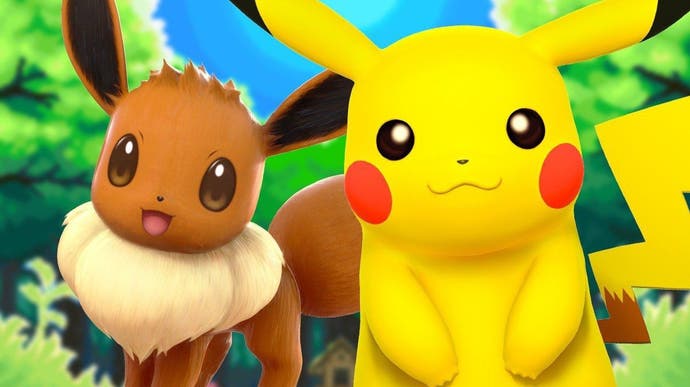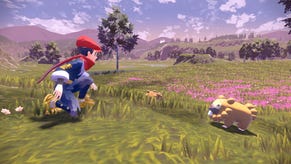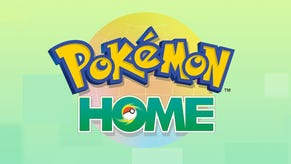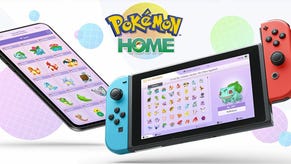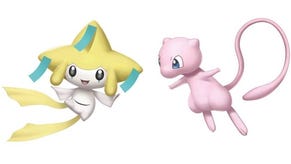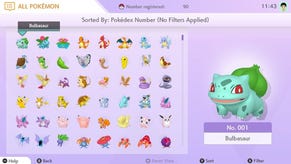Pokémon Let's Go! Pikachu and Eevee is a startlingly basic reboot
Ultra balls.
After spending some time with Pokémon Let's Go! Pikachu and Eevee, I now understand why The Pokémon Company was at pains to break tradition and mention its plans for a separate, full RPG game in 2019. If it wasn't clear from the brief snippets of footage shown in Pikachu and Eevee's reveal trailer, a few minutes of hands-on gameplay confirms these Pokémon games are very different from the ones you are used to - even more than I was expecting.
Despite the familiar Kanto region setting and the franchise's original, best known crop of Pokémon characters, Let's Go! Pikachu and Eevee's simplicity is immediately evident when you pick up its optional but fun Pokéball controller, whose single input is a clickable control stick which can handle direction and confirm actions. With this, and a few wrist gestures, you can control the full game.
There's something remarkable about this - and something solidly Nintendo about the little device itself - and I was surprised how well it worked overall. Holding it in the palm of your hand (wrist-strap attached, of course), you simply ensure the top of the ball (the upper red part) is the side closest to the screen so you are aiming it in the right direction. The ball's gyro-powered throwing mechanic works accurately, but the best part is its rumble, which jolts and tremors convincingly when a Pokémon is seemingly captured inside.
But while the accessory is a fun extra, Pikachu and Eevee's changes to the core experience are very much inescapable - and I was taken aback at how much the traditional Pokémon experience has been altered. While the removal of random battles makes traversal less frustrating, the fact there's no battling wild Pokémon at all - just Go-style capturing and throwing - is a startling concession. Was this done to remove the slightly jarring need to attack, freeze, or paralyze a cute creature before enslaving them as your own? Or was it done because this is how things work in Go, and therefore is easier for that audience of players to understand?
Many of the other differences from Pokémon's core series will also be familiar to Go players. In Let's Go Pikachu and Eevee, Pokémon strength is represented by a CP number, which exists to round up the usual, more detailed stats. The use of candy to power up Pokémon is another Go feature, as is Go's familiar fruit basket of berries to aid in the capture process in identical ways. All of these changes are rooted in the popularity of Pokémon Go, and its simpler, streamlined mobile gameplay.
Pikachu and Eevee's E3 demo is limited - we got to play less than Nintendo ended up showing on its Treehouse Live stream. Essentially confined to Viridian Forest, our time with the game extended to little more than catching Pidgeys and battling the local low-level trainers, and we were not able to explore the game's map further or poke about in any of its menus. You could catch the traditional Kanto starter Pokémon in this area, although otherwise it was an exact replica of the area from Red, Blue and Yellow. Upon reaching Pewter City, I was informed I had reached the demo's limits, although on the Treehouse stream you will have been able to watch the player character continue on a little, briefly meeting with their rival and then greeting Brock, who is once again the city's gym leader.
There was no chance to battle another player or try out the game's dual play mechanics. Less surprising, there was no way to witness the hard link between Go and Let's Go! - the ability to transfer creatures from the mobile game to your Switch via the Go Park area, which replaces the Kanto region's Safari Zone.
It is easy to see how Pokémon Let's Go Pikachu and Eevee's simplicity will entice younger players or those less familiar with the Switch, who can play using the Pokéball controller, sat back on the sofa while the console and its standard Joy-Con controllers are docked away. For those looking for an entry point into Pokémon games having played Go, Pikachu and Eevee may well serve as that bridge - which I'm sure is the intention, before the ramp up to the return of the usual mechanics in 2019's entry. But for me, as a longtime fan but also a Go addict, the games' nostalgia factor is dented by the limitations.
It's a shame, too, because these are the best-looking Pokémon games to date by a country mile - their visual style a perfect balance between the anime and the original Pokémon games - and the return to Kanto is more than welcome. There were hints in the demo to the standard gameplay lying beneath the changes - a path cut off by a tree I couldn't cut down unless I had a Pokémon to do so, and the EXP share item levelling up my party. I remain convinced the Switch is the perfect platform for a proper Pokémon game. From this demo, though, I'll be waiting until 2019 to play it.
